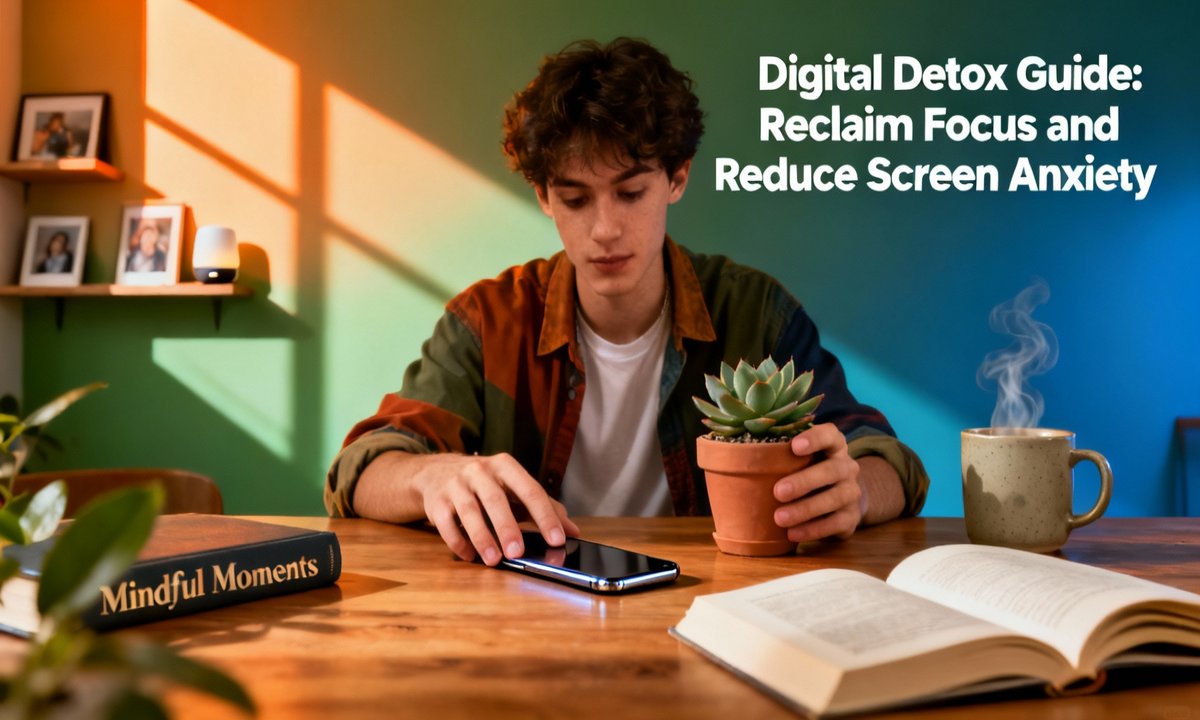A digital detox is an intentional break from constant screen time, designed to help us rediscover balance and reduce the anxiety that often comes with our always-connected lives. In the United States, where screen usage can easily exceed ten hours daily, finding a healthy relationship with our devices is vital for both well-being and productivity.
Why a Digital Detox Now?
The endless stream of notifications, habitual scrolling, and the pressure to always be reachable contribute significantly to widespread technology burnout and screen anxiety. These digital habits can unfortunately lead to chronic stress and a restless mind, highlighting why a digital detox is not just beneficial, but frequently essential. Taking this step can restore focus and improve overall mental health.
What Is a Digital Detox?
A digital detox involves a deliberate reduction or temporary pause from using digital devices, especially smartphones and social media platforms. It offers an opportunity to step back, reflect on our usage, and establish new, healthier boundaries for daily digital routines. The increasing prevalence of remote work and an “always-on” culture in the US makes these breaks more critical than ever, supporting mindful technology use. Discover why this practice is increasingly important in our modern world.
Even short periods away from screens can significantly restore focus, reduce anxiety levels, and foster more meaningful real-life connections, countering common technology burnout symptoms like fatigue and poor sleep. Learn more about the confirmed benefits of taking a digital break.
Recognizing Signs of Screen Anxiety
Wondering if a digital detox could benefit you? Many people experience symptoms of digital overuse, which can manifest in various ways. These include developing “tech neck” from prolonged device use, or experiencing persistent eye strain after long hours looking at screens.
Another common sign is nomophobia, which describes the anxiety felt when you are separated from your phone, along with phantom vibrations, where you imagine your device alerting you. Irritability and a tendency to withdraw from face-to-face interactions are also key indicators. A recent study indicated that a significant portion of US adults, around 66%, experience some form of nomophobia. Learn more about these prevalent digital anxieties and their impact.
Beyond these physical and psychological signs, increased screen time often contributes to higher anxiety levels, disrupted sleep patterns, and noticeable mood swings. Recognizing these symptoms is the first step toward reclaiming your well-being. Just as tidying your physical space can boost your mental state, decluttering your digital life can profoundly improve your mental health. Explore how decluttering can enhance well-being.
The Emotional Cost of Digital Overload
Unchecked digital habits can subtly erode our capacity for sustained focus and effective mood regulation. This often makes minor daily frustrations feel much more overwhelming than they should. When screen fatigue becomes a constant companion, even activities we once enjoyed can lose their spark and appeal.
The persistent compulsion to check devices creates a challenging cycle: more time spent online often leads to less satisfaction in the real world and a noticeable increase in anxiety. Understanding this cycle is crucial for breaking free and regaining control over your emotional well-being. Dive deeper into the emotional impact of constant digital engagement.
Documented Benefits: Why Digital Detox Improves Focus and Mental Health
Scientific research consistently supports the idea that reducing screen time offers significant and profound benefits for our overall health. These advantages span across various aspects of our lives, from improving our sleep quality to enhancing our ability to focus throughout the day.
For instance, less exposure to screens, particularly in the evening, actively supports the natural production of melatonin, which is essential for more restful and restorative sleep. By limiting digital distractions, individuals can achieve deeper concentration for work, study, or creative pursuits, sharpening their mental acuity.
Regular digital detoxes have been shown to reduce feelings of anxiety, diminish irritability, and alleviate general stress levels, fostering a calmer mind. Fewer impulsive device checks help individuals regain a stronger sense of self-control over their daily activities and time. Discover more about the wide-ranging benefits supported by medical insights.
Stepping away from screens encourages more authentic, real-life connections and meaningful conversations, strengthening personal relationships. Furthermore, many report increased life satisfaction, experiencing reduced boredom, stress, and even fewer symptoms of depression. A digital detox effectively acts as a reset button, helping you declutter your mental space and rediscover contentment through mindful technology use.
Reclaiming Your Focus
By consciously detaching from the constant stream of notifications and alerts, your brain begins to adapt, enabling longer periods of deep work and sustained concentration. Research highlights that both attention span and creative problem-solving abilities flourish when digital cues and interruptions are significantly minimized. Understand how minimizing digital cues can boost your productivity.
A thoughtfully planned digital detox empowers you to complete projects with greater efficiency, engage more deeply with loved ones, and dedicate time to offline hobbies. This might include exploring creative DIY home makeovers, allowing you to channel your energy into enriching activities beyond the screen. Find inspiration for engaging DIY home projects.
Digital Detox Trends: What’s Working in the US (2025)
Modern approaches to a digital detox emphasize building sustainable, mindful tech habits rather than aiming for a permanent disconnection. One popular trend is Digital Minimalism, which involves intentionally removing non-essential apps and online clutter, keeping only what truly adds value to your life. Explore the psychological backing behind current digital detox trends.
Another effective strategy is practicing Phone-Free Mornings, where you delay using any devices for the first hour after waking to cultivate a calm start to your day. Disabling most notifications, keeping only those that are absolutely necessary for work or emergencies, also significantly reduces interruptions.
Creating Screen-Free Zones in your home, such as bedrooms or dining tables, designates these areas as tech-free to ensure quality rest and genuine social interaction. Incorporating Scheduled Breaks, using built-in tools or reminders, helps you take short, regular tech-free moments, even if only for ten minutes, which can make a noticeable difference.
Many find great success with Analog Alternatives, switching to notebooks and paper planners, which are proven to boost memory and creativity. For a more intensive reset, consider a Digital Sabbatical, spending 24 to 48 hours completely offline each month. These strategies work together to shield your mind from the relentless digital buzz, bringing real life back into clear focus.
Practical Digital Detox Strategies: Small Steps, Big Results
Ready to begin your journey toward reclaiming focus and easing screen anxiety? Implementing these practical strategies, even in small steps, can lead to significant and positive results in your daily life.
Set Device Boundaries
One effective method is to utilize app timers or your device’s settings to place daily caps on social media or entertainment usage. Consider moving your phone charger to another room, ensuring your device isn’t the last thing you see before sleeping and the first thing you reach for upon waking. This simple change helps foster healthier sleep patterns.
Create Tech-Free Spaces
Designate specific areas in your home, such as bedrooms, the dining table, or cozy reading nooks, as entirely screen-free zones. Establishing these boundaries helps protect your precious rest periods and encourages more meaningful relationships with those around you.
Why not enhance your digital detox efforts by blending them with home improvements? Creating a comfortable and inviting reading corner, for instance, can make taking screen breaks much more appealing and enjoyable. Find inspiration for creating eco-chic, comfortable home spaces.
Schedule Unplugged Hours
Actively block out dedicated time on your calendar for tech-free evenings or commit to a weekly offline Sunday. If a complete break seems too daunting initially, begin with manageable 15-30 minute intervals of unplugged time and gradually increase their duration as you become more comfortable.
Build Offline Routines
Consciously replace habitual scrolling with engaging offline activities such as walking, journaling, or meal preparation. Preparing healthy meals can also become a tech-free family dinner tradition. Discover budget-friendly meal prep ideas for delicious, screen-free dining.
Additionally, actively encourage and participate in social activities that naturally do not revolve around screens, fostering genuine connection and interaction.
Practice Digital Mindfulness
Take moments to observe how you genuinely feel both before and after using certain apps or engaging online. Ask yourself honestly if these interactions are truly adding value to your day or primarily contributing to stress. This mindful approach helps you discern intentional use from mere habit.
Consider this your personalized jumpstart to developing a calmer, more intentional relationship with technology.
Mindful Technology Use for Long-Term Digital Wellness
While a single weekend offline can offer a powerful reset, achieving lasting change in your digital habits involves cultivating ongoing mindful practices. Regularly checking your screen time statistics and making adjustments if your usage begins to creep upwards is a key step.
Discovering and embracing analog joys, such as picking up physical hobbies or crafts like painting, cooking, or gardening, offers a refreshing alternative to screen-based entertainment. Incorporating mindfulness exercises, even brief breathing or meditation moments during your breaks, can significantly enhance your overall well-being.
Make it a habit to reflect and reset monthly, reviewing which digital routines genuinely work for you and identifying any that tend to drain your energy. Real balance in digital wellness does not demand perfection; even small, consistent steps, like leaving your phone in another room or enjoying a device-free lunch, contribute significantly.
You might find, as many others have, a profound sense of calm and increased daily satisfaction by embracing these thoughtful tips.
Building Digital Wellness Together
You are certainly not alone on this journey towards better digital wellness. Across the United States, individuals from various backgrounds—professionals, families, and students—are discovering the profound freedom and clarity that comes from practicing tech mindfulness.
For additional inspiration on cultivating intentional living and building resilience in your daily life, explore guides that delve into topics such as eco-chic home living and practical home improvements. These resources can further support your holistic well-being. Explore ideas for eco-chic home decor and enhanced comfort. Learn about optimizing your home for comfort and savings.
Resources and Further Reading
To support your ongoing journey toward digital wellness, consider exploring these helpful tools and reputable organizations. They offer valuable insights and practical assistance.
App Recommendations for Focus and Tracking
Explore applications designed to enhance your focus and help manage screen time. Tools like Forest can help you stay focused, while Freedom blocks distractions effectively. Apps such as Moment are useful for tracking your screen usage patterns.
Mental Health Helplines and Support
For mental health support, resources include the National Alliance on Mental Illness (NAMI) and Mental Health America. Local community wellness centers also provide valuable assistance and guidance.
US-Based Wellness Resources
Access reliable information and support from prominent US-based institutions such as the National Institute of Mental Health (NIMH) and the CDC’s Mental Health section (CDC – Mental Health). These organizations offer extensive public health information.
Further Reading and Insights
Deepen your understanding of digital detox through additional reading. Resources like Medical News Today on Digital Detox provide medical perspectives, and Freedom’s Digital Detox Blog offers practical advice and trends.
FAQs: Your Digital Detox Questions Answered
Q: How do I begin a digital detox if work or school requires lots of screen time?
A: When work or school demands significant screen use, focus on clearly distinguishing between essential and unnecessary digital engagement. Make it a point to schedule personal tech-free breaks outside of your obligations. Additionally, communicate your boundaries clearly with colleagues, teachers, or family to ensure your needs are understood and respected.
Q: What if I feel isolated or stressed when unplugging?
A: It is perfectly normal to experience feelings of isolation or stress, sometimes known as FOMO (Fear Of Missing Out), when you first begin to unplug. Start with very small, manageable steps. Actively connect with friends or family members offline, and gradually build up your unplugged time. These initial feelings often fade with consistent practice. Read more about navigating initial discomfort during a detox.
Q: How do I detox as a family?
A: To detox as a family, establish shared tech-free meal times or engage in activities that don’t involve screens. Build new family rituals such as regular game nights, outdoor walks, or collaborative DIY projects around the house. These shared experiences can strengthen bonds and create new memories. Explore easy DIY home projects that can add value and provide engaging family time.
Q: I tried a detox before but slipped back. What now?
A: It’s important to remember that consistency is more valuable than striving for unattainable perfection. Reflect honestly on what factors made maintaining consistency challenging during your previous attempt. Set up gentle reminders for yourself and actively celebrate every small step you take, no matter how minor it seems. Each effort is progress.
Conclusion: Take the First Step Toward Digital Wellness
A digital detox is not about adhering to strict, rigid rules, but rather about discovering what truly brings you clarity, balance, and authentic joy in your life. The numerous benefits, including sharper focus, significantly reduced anxiety, and enhanced self-control, will accumulate and become more pronounced over time.
Remember that progress, no matter how gradual, consistently outweighs the pursuit of perfection. Taking control of your screen time allows you to observe how profoundly life can change when you mindfully choose to unplug.
If you found this guide helpful, consider sharing your experience in the comments section below. Together, we can foster a culture that embraces more mindful and balanced technology use for everyone.



